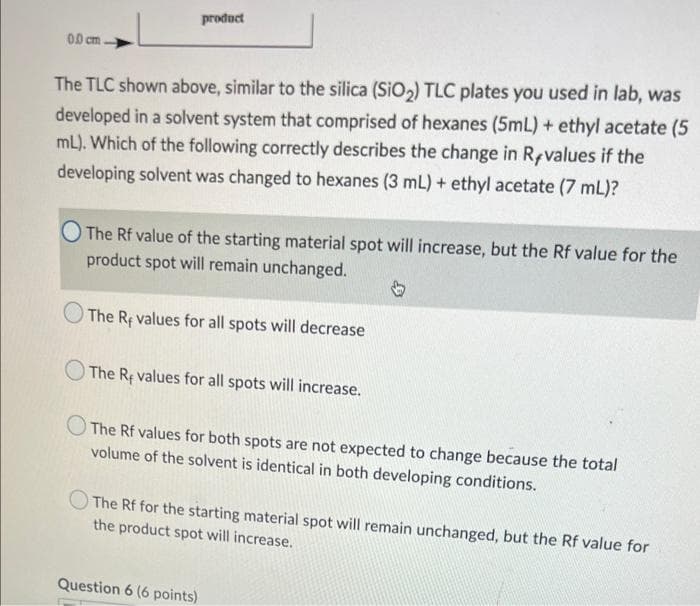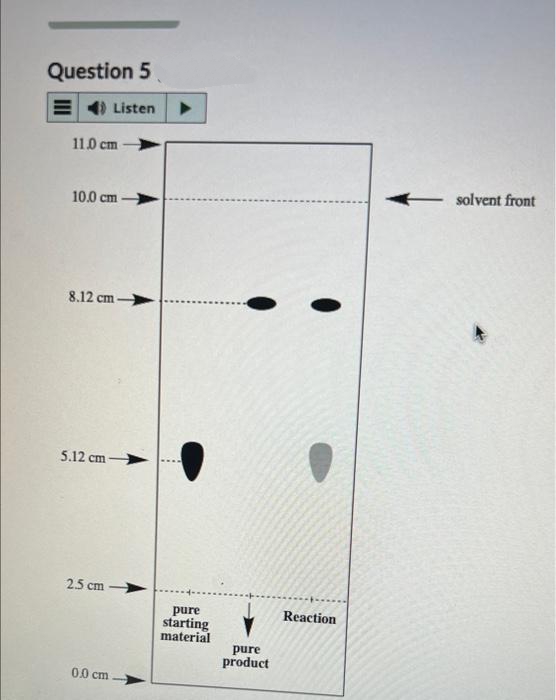The TLC shown above, similar to the silica (SiO₂) TLC plates you used in lab, w developed in a solvent system that comprised of hexanes (5mL) + ethyl acetate mL). Which of the following correctly describes the change in Revalues if the developing solvent was changed to hexanes (3 mL) + ethyl acetate (7 mL)? The Rf value of the starting material spot will increase, but the Rf value for th product spot will remain unchanged. ↓ The Rf values for all spots will decrease The Re values for all spots will increase. The Rf values for both spots are not expected to change because the total volume of the solvent is identical in both developing conditions. The Rf for the starting material spot will remain unchanged, but the Rf value for the product spot will increase. Question 6 (6 point)
The TLC shown above, similar to the silica (SiO₂) TLC plates you used in lab, w developed in a solvent system that comprised of hexanes (5mL) + ethyl acetate mL). Which of the following correctly describes the change in Revalues if the developing solvent was changed to hexanes (3 mL) + ethyl acetate (7 mL)? The Rf value of the starting material spot will increase, but the Rf value for th product spot will remain unchanged. ↓ The Rf values for all spots will decrease The Re values for all spots will increase. The Rf values for both spots are not expected to change because the total volume of the solvent is identical in both developing conditions. The Rf for the starting material spot will remain unchanged, but the Rf value for the product spot will increase. Question 6 (6 point)
Chemistry
10th Edition
ISBN:9781305957404
Author:Steven S. Zumdahl, Susan A. Zumdahl, Donald J. DeCoste
Publisher:Steven S. Zumdahl, Susan A. Zumdahl, Donald J. DeCoste
Chapter1: Chemical Foundations
Section: Chapter Questions
Problem 1RQ: Define and explain the differences between the following terms. a. law and theory b. theory and...
Related questions
Question
Which of the following correctly describes the change in Rf values if the developing solvent was changed to Hexanes (3mL) + ethyl acetate (7mL) ?

Transcribed Image Text:0.0 cm.
product
The TLC shown above, similar to the silica (SiO₂) TLC plates you used in lab, was
developed in a solvent system that comprised of hexanes (5mL) + ethyl acetate (5
mL). Which of the following correctly describes the change in Revalues if the
developing solvent was changed to hexanes (3 mL) + ethyl acetate (7 mL)?
The Rf value of the starting material spot will increase, but the Rf value for the
product spot will remain unchanged.
The Re values for all spots will decrease
The Re values for all spots will increase.
The Rf values for both spots are not expected to change because the total
volume of the solvent is identical in both developing conditions.
The Rf for the starting material spot will remain unchanged, but the Rf value for
the product spot will increase.
Question 6 (6 points)

Transcribed Image Text:Question 5
Listen
11.0 cm
10.0 cm-
8.12 cm-
5.12 cm-
2.5 cm -
0.0 cm-
pure
starting
material
pure
product
Reaction
solvent front
Expert Solution
This question has been solved!
Explore an expertly crafted, step-by-step solution for a thorough understanding of key concepts.
Step by step
Solved in 4 steps with 3 images

Knowledge Booster
Learn more about
Need a deep-dive on the concept behind this application? Look no further. Learn more about this topic, chemistry and related others by exploring similar questions and additional content below.Recommended textbooks for you

Chemistry
Chemistry
ISBN:
9781305957404
Author:
Steven S. Zumdahl, Susan A. Zumdahl, Donald J. DeCoste
Publisher:
Cengage Learning

Chemistry
Chemistry
ISBN:
9781259911156
Author:
Raymond Chang Dr., Jason Overby Professor
Publisher:
McGraw-Hill Education

Principles of Instrumental Analysis
Chemistry
ISBN:
9781305577213
Author:
Douglas A. Skoog, F. James Holler, Stanley R. Crouch
Publisher:
Cengage Learning

Chemistry
Chemistry
ISBN:
9781305957404
Author:
Steven S. Zumdahl, Susan A. Zumdahl, Donald J. DeCoste
Publisher:
Cengage Learning

Chemistry
Chemistry
ISBN:
9781259911156
Author:
Raymond Chang Dr., Jason Overby Professor
Publisher:
McGraw-Hill Education

Principles of Instrumental Analysis
Chemistry
ISBN:
9781305577213
Author:
Douglas A. Skoog, F. James Holler, Stanley R. Crouch
Publisher:
Cengage Learning

Organic Chemistry
Chemistry
ISBN:
9780078021558
Author:
Janice Gorzynski Smith Dr.
Publisher:
McGraw-Hill Education

Chemistry: Principles and Reactions
Chemistry
ISBN:
9781305079373
Author:
William L. Masterton, Cecile N. Hurley
Publisher:
Cengage Learning

Elementary Principles of Chemical Processes, Bind…
Chemistry
ISBN:
9781118431221
Author:
Richard M. Felder, Ronald W. Rousseau, Lisa G. Bullard
Publisher:
WILEY